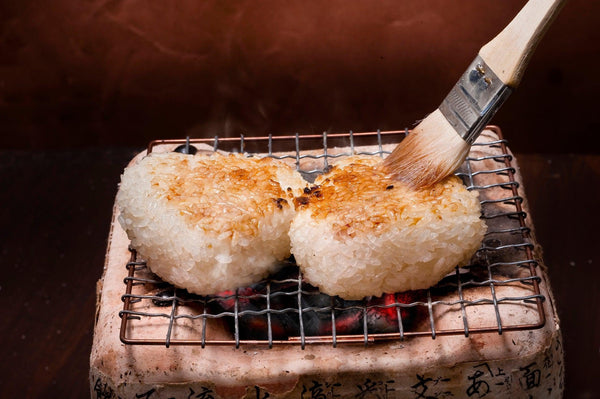
Jump to:
When you think of sweet soy sauce, what is the first thing that comes to mind? If you are familiar with Asian cuisine, then the Indonesian Kecap Manis may ring a bell, but did you know that Japan has their own version of sweet soy sauce too?
Soy sauce, or shoyu, is one of the most commonly used seasonings in Japan. Depending on the region, the flavor of soy sauce can differ quite a bit too. In the Kyushu region of Japan, sweet soy sauce, or amakuchi shoyu, is the soy sauce of choice. But, what is sweet soy sauce, and how does it differ from other Japanese soy sauces? Why is it sweet, and does it taste similar to the more commonly known Japanese soy sauces? This article will explain everything you need to know about Japanese sweet soy sauce in hopes that you’ll try it out for yourself.
What Is Japanese Sweet Soy Sauce?

Japanese sweet soy sauce is one of the main 6 types of shoyu in Japan. It may be one of the lesser known soy sauces, especially compared to koikuchi or usukuchi shoyu, but it is commonly enjoyed in Kyushu, Japan’s southernmost island. It is a soy sauce that is sweetened with sugar, licorice, and/or stevia with the sweetener depending on the manufacturer.
If you travel to Kyushu, you may find it surprising that the soy sauce is sweet. This sweet element also carries into other flavors; like dashi broth which is often seasoned with shoyu.
When it comes to amakuchi shoyu, the depth of sweetness is said to vary depending on the area of Kyushu. As a rule of thumb, the further south you go, the sweeter the soy sauce becomes. In fact, Japanese sweet soy sauce is thought to be the sweetest near the coastal areas in Kyushu.
Why Is Japanese Sweet Soy Sauce Sweet?
The concept of Japanese sweet soy sauce may sound a bit surprising, especially if you are new to the world of Japanese soy sauce. If we look at a few facts about Kyushu’s history and climate, then sweet soy sauce as a concept might start to make more sense.
First, let’s take a look at Kyushu’s history with sugar usage. During the Edo Period, Japan began trading with Western countries, including the Netherlands. Trading with the Dutch specifically took place in Nagasaki via Dejima, an island right off the coast of Nagasaki. One of the main things that the Dutch imported to Japan was sugar. People in Kyushu started incorporating sugar into their cuisine, and the idea of sweet soy sauce probably came from this exchange.
Another reason why sweet soy sauce makes sense in Kyushu is because of the high temperatures. Kyushu is one of the hottest regions in Japan, especially during the sweltering summer months. Sugar and salt levels naturally deplete the body when too much sweat is lost, meaning that the body tends to crave foods that are simultaneously sweet and salty in these situations. Since soy sauce is such a common condiment and seasoning in Japanese cuisine, it just makes sense to be salty and sweet in Kyushu.
Finally, sugar cane cultivation in Japan takes place, for the most part, in Kyushu. So if the sugar is already there, then why not use it in everyday seasonings? This is another reason why soy sauce in Kyushu is sweet.
What Does Japanese Sweet Soy Sauce Taste Like?

Well, of course, it’s sweet! Especially compared to the more commonly known koikuchi or dark soy sauce. Japanese sweet soy sauce is also thought to have more of a mild flavor compared to other varieties of shoyu. It has the saltiness that soy sauce is known for, but the added sweetness gives amakuchi shoyu a unique flavor and umami that cannot be found in other Japanese soy sauces. The sweetness found in amakuchi shoyu actually balances out the entire flavor of the shoyu quite nicely.
As previously mentioned, the level of sweetness in sweet soy sauce varies depending on the region in Kyushu, with the sweetest of sweet soy sauces believed to come from Kagoshima prefecture. For those who are new to sweet soy sauce, it is recommended to start with one that is not too sweet, to get used to its unique flavor. Therefore, if you want to try sweet soy sauce, we recommend trying one from Fukuoka prefecture first, as it is the closest prefecture to Honshu or the main island of Japan.
How Is Japanese Sweet Soy Sauce Made?
Japanese sweet soy sauce can be made with bases of both light and dark soy sauce. However, it is most commonly made with a base of koikuchi or dark soy sauce. In order to turn koikuchi shoyu into amakuchi shoyu, sweeteners such as natural sugar, licorice, or stevia are added during the production process.
How To Use Japanese Sweet Soy Sauce?
Generally speaking, Japanese sweet soy sauce can be used the same way that you would use dark soy sauce, or your preferred shoyu that you normally use. It can be used both in cooking and as a dipping sauce. Just keep in mind that because it contains sugar, it will add a bit of a sweet touch to your dishes.
If you’re looking for some ideas of foods that pair well with Japanese sweet soy sauce, then here are some ideas:
Yaki Onigiri

When it comes to how to use amakuchi shoyu, this is probably the most common way it is used. Quickly whipping up some yaki onigiri or grilled rice balls and then brushing them in a sweet, salty, umami-packed sauce sounds like a match made in heaven, right? The sweet soy sauce gives yaki onigiri a unique depth of flavor that cannot be achieved when using other kinds of soy sauce.
Tamagoyaki

If you’ve had tamagoyaki, or Japanese egg roll, then you know that it can be a little bit sweet. Japanese sweet soy sauce works perfectly as the sweetening agent for tamagoyaki, and a little really does go a long way! No need to add multiple seasonings into your tamagoyaki if you have a bottle of Japanese sweet soy sauce on hand.
Miso-simmered dishes

Miso on its own has quite a strong and distinctive flavor. If you want to add a touch of sweetness and even more umami flavor to it at the same time, pair it with a little bit of sweet soy sauce in simmered dishes. The combination of miso and sweet soy sauce will give your simmered dishes or miso-flavored nabe (hot pot) a completely new yet scrumptious flavor.
Sashimi

In Kyushu, it is common for izakaya to serve sashimi platters with Japanese sweet soy sauce in place of koikuchi or tamari shoyu. The sweetness from the soy sauce pairs surprisingly well with the fattiness and natural umami of the raw fish. Why not try it out for yourself at home?
Best Japanese Sweet Soy Sauces
With amakuchi shoyu being one of the main types of shoyu found in Japan, there are without a doubt many producers making it, especially in Kyushu. In order to achieve its sweet flavor, many manufacturers opt to add flavor enhancers like high fructose corn syrup or chemicals to make the taste more appealing, (and let’s face it, to make production costs cheaper). We understand that many people feel worried about purchasing products that contain additives, and we hear you. Below, we’d like to suggest what we believe are some of the best Japanese sweet soy sauces on the market.
Our first recommendation is Goto Amakuchi Shoyu Japanese Sweet Soy Sauce. This is a great sweet soy sauce option for those who are new to the world of Japanese sweet soy sauce. Using local whole soybeans from Fukuoka prefecture, this amakuchi shoyu is not super sweet, compared to the likes of amakuchi shoyu found in southern Kyushu. If you’d like to add a bit of a sweeter touch to your cooking, then this amakuchi shoyu is the way to go!
Another thing we love about this particular sweet soy sauce is that it does not contain any artificial flavors or preservatives, something that is rare with amakuchi shoyu. In fact, this amakuchi shoyu contains only whole soybeans, wheat, salt, and sugar syrup made from rock candy.
If you’re looking for an amakuchi shoyu with a bit of a twist, then you need to try the Yamato Japanese Sweet Soy Sauce for Ice Cream. This particular soy sauce is a different take on sweet soy sauce, more catered towards ice cream and desserts. It is also sweetened with mirin and sweet sake, giving it a more unique flavor. It also has a thicker texture than conventional sweet soy sauce. It has a texture similar to black sugar syrup or even caramel sauce. It’s perfect for topping ice cream, warabi mochi, or other confectionaries.
Want to learn more about our Japanese soy sauce recommendations? Be sure to check out this article for our top 15 shoyu picks.
Where To Buy Japanese Sweet Soy Sauce?

If you’ve made it this far into the article, then you’re probably curious to try Japanese sweet soy sauce for yourself. As amakuchi shoyu is relatively unknown outside of Japan, finding it in your local Japanese or Asian grocery store may be quite the struggle. If you want to purchase authentic Japanese sweet soy sauce but can’t make it to Kyushu to try the real deal, you can have it shipped straight to your door from Japan instead. Check out our collection of Japanese sweet soy sauces to find the one that best suits your needs.
Have you ever tried Japanese sweet soy sauce? What did you think of it? If you haven’t tried it yet, have we convinced you to try it? Let us know your thoughts in the comments below!


0 comments